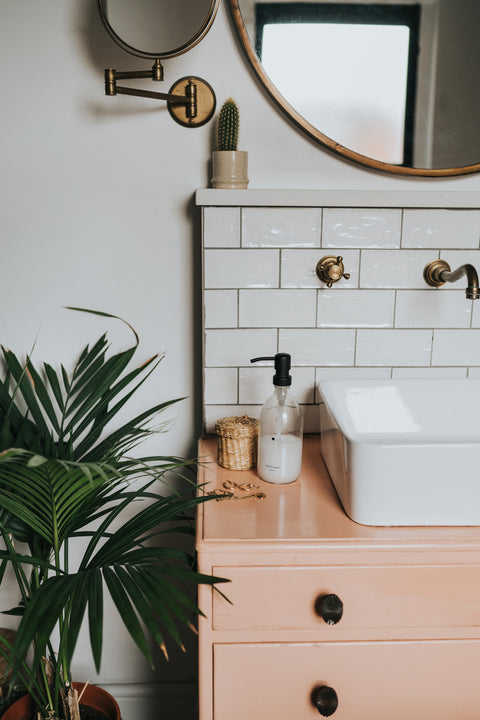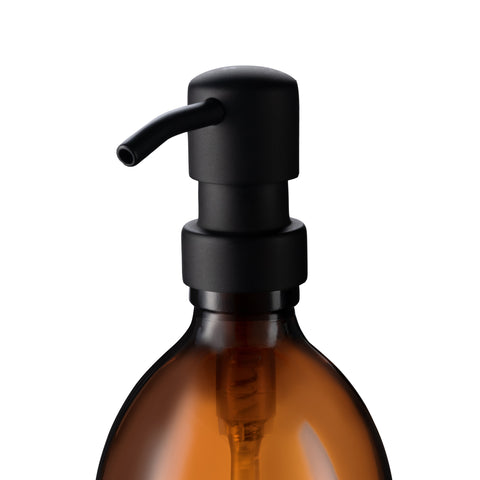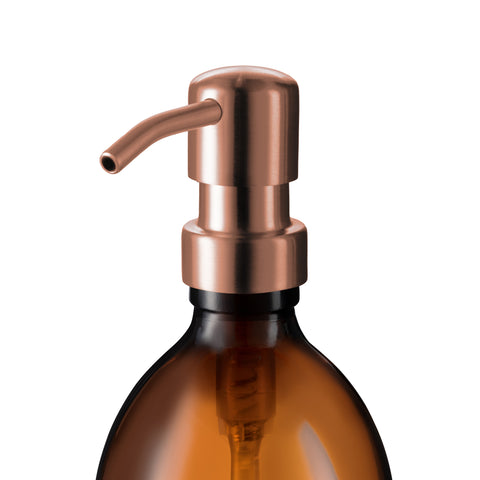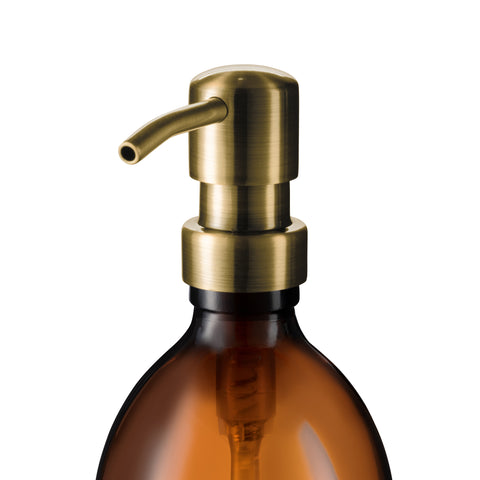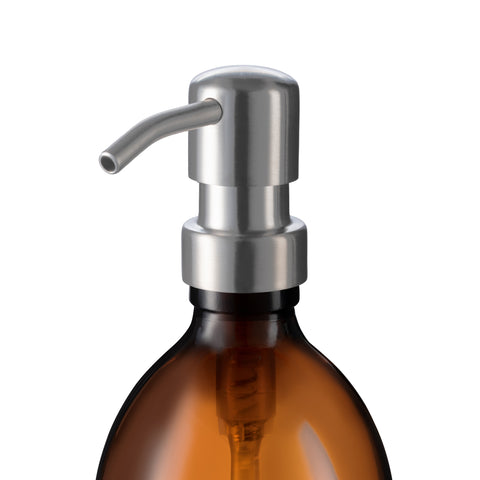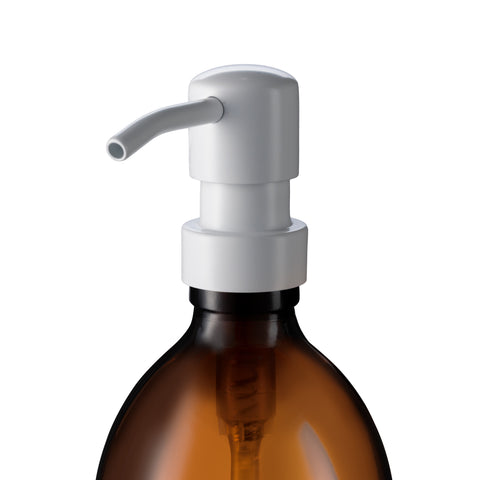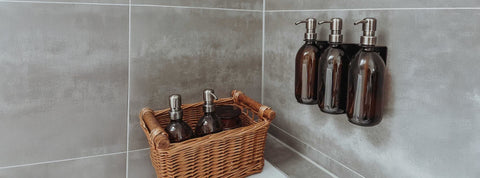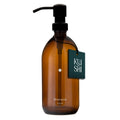Inside this Article:
When to replace dispenser parts
Your soap and lotion dispensers are part of countless small moments each day—washing hands before preparing a meal, cleansing your face in the evening, moisturizing after a shower.
These simple rituals deserve tools that work beautifully, time after time.
Yet many dispensers fail prematurely, not from poor quality, but from a lack of basic care. With the right maintenance, a well-made glass soap dispenser can serve you for years, reducing waste while keeping your space refined and functional.
Consider the average household discards approximately 216 plastic bottles each year - soap bottles included. By choosing a refillable soap dispenser and caring for it properly, you eliminate a decade's worth of plastic waste with a single, thoughtful investment.
Let's explore how to refill soap dispensers properly and maintain them for lasting performance.
How to refill soap dispensers without mess

Refilling a dispenser may seem straightforward, but a few mindful steps make all the difference between a clean process and a sticky countertop.
Begin by removing the pump gently—never force it, as this can damage the threading or dislodge internal components. A small funnel is your best companion here, guiding liquid smoothly into the bottle without spills.
Whether you're working with a refillable soap dispenser, lotion dispenser, or foaming pump, always leave a small space at the top. Overfilling prevents the pump mechanism from drawing correctly and can cause overflow when you replace the top.
Before securing the pump back in place, take a moment to wipe the bottle neck clean with a damp cloth. This removes any residue that could interfere with the seal or create buildup over time. It's a small gesture that keeps both your glass soap dispenser and pump working seamlessly.
Pro tip: If you live in a hard water area, consider using filtered or distilled water when diluting soap. Mineral deposits from tap water can accumulate inside pump mechanisms, causing stiffness and reducing the lifespan of your dispenser.
How to care for pumps and prevent clogs
Dispenser pumps—whether standard, foaming, or spray atomisers—perform best when maintained regularly. The most common issue? Clogs from soap residue, particularly when switching between different products or formulas.
Regular rinsing
Every few weeks, remove your pump and flush it through with warm water. This simple rinse prevents buildup inside the mechanism. For foaming soap dispensers, this is especially important, as the air chambers can accumulate soap film that affects foam quality.
Deep cleaning
If your soap dispenser pump feels stiff or isn't dispensing smoothly, it likely needs a deeper clean. Remove the pump and soak it in warm water with a small amount of mild dish soap for 10-15 minutes. Work the pump mechanism a few times while submerged to flush out stubborn residue, then rinse thoroughly with clean water before reassembling.
For persistent mineral buildup from hard water, gently scrub the pump with a soft brush or cloth and warm water, repeating as needed until the deposits are removed.
Prevention through proper dilution
The key to avoiding clogs is using properly diluted soap. Thick, undiluted formulas strain pump mechanisms and create buildup faster. If you're refilling with concentrated soap, always dilute according to the manufacturer's recommendations.
Your soap mixture should appear visibly watery—if it looks thick or gel-like, add more water. Most foaming dispensers work best with a 1:4 ratio (one part soap to four parts water), while standard liquid dispensers may need less dilution.
How to maintain stainless steel pumps and glass bottles

Quality materials deserve quality care. Both stainless steel pumps and glass soap dispensers are designed for durability and are a far more sustainable option, but they'll maintain their beauty longer with gentle, consistent attention.
For stainless steel pumps
Wipe your pump regularly with a soft, damp cloth to remove fingerprints and soap residue. Avoid abrasive cleaners or harsh chemicals that can damage the finish or cause discolouration. For extra shine, buff dry with a microfiber cloth after cleaning.
This simple routine keeps your dispenser looking refined while protecting the metal from moisture-related wear.
Never use bleach, ammonia-based cleaners, or abrasive scrubbing pads on stainless steel—these will damage the finish and may compromise the pump's protective coating.
For glass bottles
Clean your glass soap dispenser or amber glass soap dispenser with warm water and mild soap. Avoid extreme temperature changes that could cause thermal shock. If you notice cloudiness or soap film inside, fill the bottle with warm water and a splash of white vinegar, let it sit for an hour, then rinse thoroughly.
Your dispenser will look crystal clear again.
Amber glass dispensers not only bring warmth to your space—they also protect natural soap formulas from light degradation, extending the life of botanical ingredients.
For wall-mounted dispensers
Check mounting hardware periodically to ensure it remains secure. Wipe down both the dispenser and wall plate to prevent soap buildup around edges. This keeps everything functioning smoothly and maintains a clean, intentional aesthetic in your space.
When to replace soap dispenser pump components

Even with excellent care, there will come a time where your pump mechanisms eventually wear out. Knowing when to replace parts—rather than the entire dispenser—is both practical and sustainable.
Signs your pump needs replacement include;
- Inconsistent dispensing (sometimes works, sometimes doesn't)
- Visible cracks in the pump mechanism
- The pump no longer springs back after pressing
- Persistent leaking around the pump base
- Stripped threading that won't seal properly
- Increasing stiffness despite regular cleaning
Rather than discarding your entire glass soap dispenser, consider replacement pumps.
Most quality dispensers, including Kuishi designs, offer compatible replacement parts. This approach extends the life of your dispenser while reducing unnecessary waste—a simple way to honour both your investment and the environment.
Quality matters from the beginning.
Kuishi soap dispensers feature upgraded pump mechanisms with stronger springs, ensuring smooth, reliable action that lasts.
Our 304-grade stainless steel components resist corrosion even in moisture-rich environments—thoughtful engineering for lasting performance. A twelve-month guarantee on the pump mechanism backs each dispenser.
Troubleshooting common dispenser problems
How to fix a pump bottle not pumping?
First, ensure you haven't overfilled the bottle. If there's adequate space, remove the pump and check that the tube hasn't become disconnected or clogged. Rinse the entire pump assembly with warm water and reassemble. If you're using a new or recently emptied dispenser, press the pump several times to prime it—this draws soap into the mechanism.
Why is my soap pump stuck, stiff, or sticky?
This usually indicates soap residue or mineral buildup.
Remove the pump and soak it in warm water for 15 minutes, working the mechanism several times while submerged. For stubborn stiffness, soak the spring in warm soapy water for a few minutes, then rinse thoroughly.
Why does soap look chalky and crystalised?
This happens when soap dries on the exterior, particularly with natural formulas. Wipe the pump area daily with a damp cloth, and ensure you're using properly diluted soap. Natural soaps, while excellent for your skin and the environment, can crystallise more readily than synthetic formulas—regular cleaning prevents buildup.
Why is my foaming dispenser not foaming properly?
Check your soap-to-water ratio. Most foaming dispensers require a 1:4 ratio (one part soap to four parts water). Too much soap overwhelms the air mechanism and prevents proper foam formation.
The mixture should look quite watery—don't worry, it will foam beautifully when dispensed.
What if my soap dispenser has a hard water buildup?
If you live in an area with hard water, mineral deposits can accumulate inside the pump mechanism over time, causing stiffness and reduced performance.
Use filtered or distilled water when diluting soap, or rinse your pump weekly with a white vinegar solution to dissolve mineral buildup before it becomes problematic.

Common mistakes to avoid
Using tap water in hard water areas
Minerals in hard water create deposits that gradually clog pump mechanisms. Switch to filtered or distilled water for diluting soap—it's a small change that significantly extends pump life.
Making soap mixture too thick
Your diluted soap should be visibly watery, not gel-like. When in doubt, add more water. A mixture that is too thick strains the pump and causes premature wear.
Overfilling the bottle
Always leave space at the top. Overfilling prevents proper pump function and can cause spills when you screw the pump back on.
Using harsh cleaners on stainless steel
Bleach, ammonia, and abrasive cleaners damage stainless steel finishes. Stick to soft cloths and gentle cleaning—your dispensers will thank you with years of beautiful performance.
Ignoring early warning signs
A slightly stiff pump or occasional dispensing issues are early signals that maintenance is needed. Addressing these immediately with a simple cleaning prevents bigger problems later.
Everyday rituals, made to last
A dispenser is something you reach for many times throughout your day. By refilling carefully, maintaining pumps with simple rinses, and replacing only what's needed, you ensure these essential tools remain beautiful and functional for years to come.
This mindful approach keeps your bathroom or kitchen organised while supporting a more conscious way of living—one where quality items are cared for rather than replaced.
Each time you choose to refill rather than discard, you're participating in something meaningful. You're reducing plastic waste, saving money, and creating a home environment that reflects your values.
These small, repeated choices add up to genuine impact—the kind that makes a difference not just in your space, but in the world beyond it.
15% Reader Discount
Thank you for investing time in learning how to care for your dispensers properly. As a gesture of appreciation, we're pleased to offer 15% off any replacement pumps.
Use code: CARE15 at checkout


